| |
Glossary of Coral Reef Terminology - S
S phase - the cell cycle phase during which the DNA doubles with replication of the chromosomes |
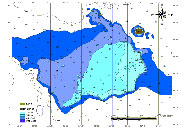
Bathygraphic map of the Saba Bank area with depth contours down to 1000 meters. the bank proper is bounded by the 200 meter depth contour (dark blue area is 200-500 meters). (Map: Saba Environmental Department)
|
Saba Bank - the Saba Bank (17o25’ N, 63o30’ W) is an undersea elevation with a flattened top, located 3–5 km southwest of the island of Saba. It is raised about 1000 m above the surrounding sea floor. With a length of 60 to 65 km and a width of 30 to 40 km, the total surface area is approximately 2,200 km2, as measured from 11-200 meter depth. Approximately Seventy-three percent of this area is shallower than 50 m. Saba Bank is a submerged, living, atoll which ranks among the largest in the world. The total surface area of the Bank where reef structures are present is estimated at approximately 150 km2, of which 20-40 km2 is estimated to consist of actively growing coral reef. Because of this large expanse of reef and the prevailing westerly ocean currents, the bank likely represents an important source of eggs and larvae of corals, fishes, crustaceans, mollusks, and other kinds of marine life for the many islands lying to the west and north-west of the bank, including the Virgin Islands and Puerto Rico |

A sabellid worm in its parchment tube. (NOAA/ Dr J.McVey)
|
sabellid worm - a marine polychaete worm in the family Sabellidae which lives in flexible tubes constructed of sand grains embedded in mucus |
safety stop - on ascending from a dive, a safety stop is a specified time spent by a scuba diver at a specific depth, for nitrogen off-gassing. While not mandatory during a no-decompression dive, it is a sound safety practice. A safety stop may be 3-5 minutes at 10-15 ft below the surface |
sagittal - relating to the sagittal plane, which extends through the midline of a bilateral animal, dividing it into two equal halves |
sagittiform - arrow-shaped |
Saharan dust - large quantities of dust, originating in the Sahara desert of Africa, are blown across the Atlantic Ocean each summer, and may be a contributing factor for the declining health of Caribbean coral reefs. The dust may modify clouds and rainfall both in Africa and across the tropical North Atlantic as far away as Barbados. Other studies suggest that the dust may play a role in determining the frequency and intensity of hurricanes formed in the eastern Atlantic Ocean |
sahel - the transition zone in Africa between the Sahara Desert to the north and tropical forests to the south. This dryland belt stretches across Africa and is a contributor to Saharan (mineral) dust |
salinity - a measure of the salt concentration of water |
salt - an ionic compound composed of a positively charged cation and a negatively charged anion, so that the product is neutral and without a net charge. These ions can be inorganic (Cl-) as well as organic (CH3-COO-) |
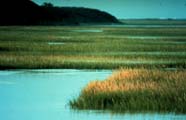
A salt marsh. (Photo: NOAA)
|
salt marsh - a marsh periodically flooded by marine water |
sampling - the probabilistic, systematic, or judgmental selection of a sub-element from a larger population, with the aim of approximating a representative picture of the whole |
sampling bias - the tendency of a sample to exclude some members of the sampling universe and over-represent others |
sampling error - the variability of a statistic from sample to sample due to chance |
sampling unit - the sub-element of the total population selected for sampling |
sampling universe - the largest entity to be described, of which the sample is a part |
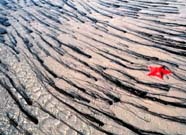
Tidal current patterns in the sand and sea grass at low tide.
|
sand - coarse sediment typically found in areas exposed to currents and wave energy |

A patch reef surrounded by sand flats. (Photo: http://www.biosbcc.net)
|
sand flat - sandy areas found in depressions and gullies in a coral reef, or between patch reefs, or in deeper areas below or beyond the reef. Seemingly near barren during the day, at night sand flats teem with biological activity; also a sandy tidal flat barren of vegetation. A tidal flat is an extensive, nearly horizontal, marshy or barren tract of land that is alternately covered and uncovered by the tide. It consists of unconsolidated sediment (mostly mud and sand) |
sandflat - a flat expanse of sand on the coast or in an estuary |
sanguivore - an animal that obtains its nourishment primarily as blood |
sanguivore - an organism feeding principally on blood |
saprophyte - any plant that lives and feeds on dead organic matter |
saprotroph - an organism which feeds on dead and decaying organisms, allowing the nutrients to be recycled into the ecosystem. Fungi and bacteria are two groups with saprophytic members |
Sargasso Sea - the region of the North Atlantic Ocean to the east and south of the Gulf Stream system. This is a region of convergence of the surface waters, and is characterized by clear, warm water, a deep blue color, and large quantities of a floating brown alga called sargassum or gulf weed |
sargassum - brown algae (Sargassum muticum) with rounded bladders that forms dense floating masses in tropical Atlantic waters, as in the Sargasso Sea |
satellite - a small celestial body orbiting a larger one; a man-made object designed to orbit a celestial body; a subviral particle composed of a nucleic acid. For their multiplication, satellites depend on coinfection of a host cell with a helper (master) virus |
satellite chromosome - a chromosome that is an addition to the normal genome |
satellite colony - a colony that develops within the tissue of a parent colony and which has its own unattached skeleton |
satellite DNA - that portion of DNA in eukaryotic cells which consists of highly repetitious sequences of bases (nucleotides) occurring tandemly (end-on-end), typically in the range from 5 to 500 bases. Satellite DNA is located at very specific spots in the genome and can be isolated from the rest of the DNA by density gradient centrifugation, forming a second or "satellite" band |
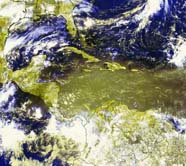
GOES-8 (May 1999) image of airborne dust over the Caribbean Sea. This dust originated in the Sahara Desert where it was carried off the coast by strong winds.
|
satellite imagery - a representation of the measurement of energy emitted or reflected by the Earth in a variety of wavelengths. Earth observation imagery takes a number of forms, of which the most traditional are optical and near-infrared radiation, from about 0.4 (blue) to 2.0 (IR) micrometers. Apart from visual and near-infrared, other bands of the spectrum commonly used include thermal infrared (heat) and microwave (radar). Each of these has its own applications |
satellite mapping - digital maps derived from satellite images |
satellite virus - a satellite which encodes the coat protein in which its nucleic acid is encapsulated |
saturation - in diving, the degree to which a gas is dissolved in the blood or other tissues. Full saturation occurs when the pressure of gas dissolved in the blood or tissues is the same as the ambient pressure of that gas |
saturation diving - the situation where a diver is at a depth or pressure for a long enough period of time (12 hours or longer) to have the partial pressures of the dissolved gases in the body at equilibrium with the partial pressure of the gases in the surrounding environment. Scientists are able to live in and work around underwater habitats for extended periods without the risk of developing decompression sickness (the bends). Divers breathe compressed air mixed with light, inert gases, such as helium. When the diver's blood becomes saturated with helium, the time required for decompression, even if the diver returns to the surface after a period of weeks, is no greater than that required after a dive lasting just a few hours |
savanna (savannah) - a tropical and subtropical grasslands biome characterized by drought-resistant vegetation dominated by grasses with scattered trees and brush |
saxitoxin - a powerful biotoxin produced by bacteria in certain marine dinoflagellates. Saxitoxin may be concentrated in the tissues of filter feeding shellfish, and results in shellfish poisoning when ingested by humans; also known as mytilotoxin |
scaffold - the eukaryotic chromosome structure which remains when DNA and histones have been removed.The scaffold is made from nonhistone proteins |
scalaradial - an antiinflammatory drug derived from the marine sponge Cacospongia scalaris |
scale - the degree of resolution at which ecological processes, structures, and changes across space and time are observed and measured |
scale-like corallites - corallites that form a pattern which resembles fish scales |
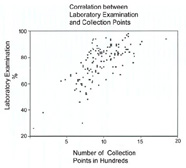
A scatter diagram.
|
scatter diagram - a two-dimensional histogram showing the joint probability density of two variables within a data sample; it is used to interpret data by graphically displaying the relationship between two variables |
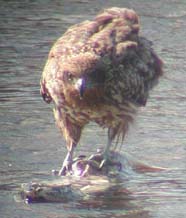
A scavenger feeding on a dead aquatic animal.
|
scavenger - an animal that feeds on dead or decaying organic matter |
schizocoelous - the mesoderm and coelom initially develop from a solid block of mesodermal tissue in an embryo that subsequently develops a split down the middle.The cavity thus formed is the coelom. Schizocoelous development of the coelom occurs in protostomes |
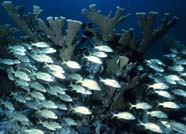
A school of smallmouth grunt with elkhorn coral in the background. (Photo: Paige Gill, Florida Keys NMS)
|
school - a social group of fishes (and some other aquatic animals), usually of the same species, which tends to orient and move in the same direction |
schreckreaktion - an alarm response in some fishes as a result of an alarm substance (schreckstoff), or alarm pheromone being introduced into the water via rupture of specialized dermal club cells. Presumably a fish attacked by a predator releases schreckstoff into the water, resulting in the conspecifics making a variety of coordinated escape or fright actions |
schreckstoff - a chemical alarm substance (a pheromone) produced by the skin of some groups of fishes when injured. It stimulates conspecifics and perhaps some other fishes to exhibit fright and escape movements |
science - a method of learning about the physical universe by applying the principles of the scientific method, which includes making empirical observations, proposing hypotheses to explain those observations, and testing those hypotheses in valid and reliable ways; also refers to the organized body of knowledge that results from scientific study |
scientific law - a statement of a scientific fact or phenomenon that is invariable under given conditions. A law may be either quantitative (including measurement) or qualitative (general characteristics). It must describe evidence that has been gathered using acceptable scientific standards of reproducibility. Examples of scientific laws: Faraday’s Law of electromagnetic induction, Coulomb’s Law of electrostatic attraction, Dalton’s Law of partial pressures, and Boyle’s Gas Law |
scientific name - the Linnaean binomial. A name of a species composed of two words: the genus (or generic) name and the species (or trivial) name, e.g., Acropora palmata. The scientific name is always written in italics. The first letter of the generic name is always capitalized; that of the species name is never capitalized |
sciophilous - thriving in conditions of low light intensity |
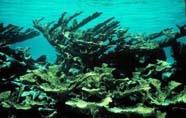
A scleractinian - elkhorn coral (Acropora sp.)
|
Scleractinia - an order of Cnidaria, usually producing calcareous skeletons with hexameral symmetry |
sclerite - a skeletal element in octocorals. Sclerites are composed of calcite spicules; also, a hard plate or element of the exoskeleton of some arthropods |
scleroblast - a cell within the mesoglea of octocorals that produces a sclerite |
sclerocyte - a cell in sponges that produces spongin or spicules |
sclerodermite - the basic unit of coral skeletal microstructure. A center of calcification from which bundles of acicular aragonite crystals radiate outward; the hard integument of Crustacea. |
scleroseptum - one of many radiating calcareous partitions in the skeletal cup (corallite) of stony corals |
Sclerospongiae - a small cass of coralline sponges (phylum Porifera) which are found inhabiting coral reefs. They possess a leuconoid grade of construction and are unique in having an internal skeleton of siliceous spicules and spongin fibers like those of the Demospongiae, together with a massive calcareous basal skeleton. They are often included in the class Demospongiae |
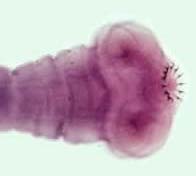
The scolex of the tapeworm, Taenia solium. (Photo: Center for Disease Control)
|
scolex - the knoblike anterior end of a tapeworm, having suckers and/or hooklets that, in the adult stage, serve as organs of attachment to the host organism |
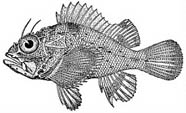
The coral scorpionfish, Scorpaena albifimbria. (Illustration: NOAA)
|
scorpionfish - any of about nearly 400 species of bony fishes in the family Scorpaenidae. Scorpionfishes have large, heavily ridged and spined heads.They possess venomous spines on their dorsal fins, each with a groove and venom sac. Scorpionfishes are well camouflaged to blend in with their environment with fleshy projections and background coloration. Some can change their color to better match their surroundings. The most venemous fish in the world, the reef stonefish (Synanceia verrucosa), is disguised to look like a encrusted rock or lump of coral. This species is widely distributed throughout tropical, marine waters of the Indo-Pacific. Most species of scorpionfishes are demersal, living on or near the bottom. They are carnivorous ambush predators feeding on crustaceans, cephalopods and fishes |
scotoscope - an instrument for detecting objects in darkness |
scrub - dense vegetation consisting of stunted trees or bushes, forming the seral stage of succession between open habitat and woodland |
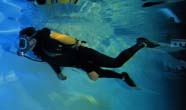
Diver training with a full face mask and underwater communications.
|
SCUBA (Self-Contained Underwater Breathing Apparatus) - a diving mode independent of surface air supply in which the diver uses open circuit self-contained underwater breathing apparatus which supplies air or breathing gases at ambient pressure |
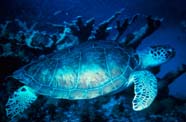
Sea turtle with shell comprised of hard, platelike scutes.
|
scute - an external horny, chitinous or bony plate or scale, such as those on the shell of a turtle |
scutiform - shield-shaped |
sea - a subdivision of an ocean |
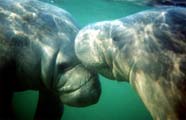
The West Indian Manatee, trichechus manatus, in Florida bay. (Photo: Copyright Laurel Canty-Ehrlich, NOAA)
|
sea cow - a large, herbivorous aquatic mammal of the order Sirenia that contains two Recent families: Dugongidae for the genera Dugong (dugong, one species) and Hydrodamalis (Steller's sea cow, one species hunted to extinction); and trichechidae for the single genus trichechus (manatees, three species). The dugong inhabits coastal regions in the tropical parts of the Old World, and some individuals go into estuaries and rivers. Steller's sea cow inhabited the Bering Sea, and was the only Recent member of this order adapted to cold waters. Manatees live along the coast and in coastal rivers in the southeastern United States, Central America, the West Indies, northern South America, and western Africa |

Tentacles at the anterior end of the body of this sea cucumber secrete a substance which aids in the capture of detritus and small organisms on sand and rock bottom. The diving tool (knife) is for scale (Photo:E. Williams NURP/NOAA)
|
sea cucumber - an echinoderm in the class Holothuroidea. Sea cucumbers possess a flexible, elongated body and leathery skin, and tentacles surrounding the mouth. Although they don't superficially resemble other members of the phylum Echinodermata, they retain pentameral (five-rayed) symmetry, with five rows of tube feet running from the mouth down along the sides of the body. Sea cucumbers are an abundant and diverse group that are found in nearly every marine environment, but are most diverse on tropical, shallow-water coral reefs.They are economically important in two main ways. They produce chemical compounds that are of interest to pharmaceutical firms, and as a food item in Asia, they form the basis of a multimillion-dollar industry that processes the body wall for sale as beche-de-mer or trepang |
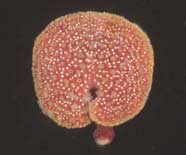
The sea pansy, Renilla reniformis, is a colonial soft coral which anchors itself to the substratum, but is able to crawl about using its leaf-like primary polyp (Photo: South carolina Department of Natural Resources Southeastern Regional Taxonomic Center)
|
sea pansy - a soft coral in the order Pennatulacea and subclass Alcyonaria. A sea pansy is a colony of polyps having different forms and functions. A single, leaf-like, giant primary polyp up to two inches in diameter forms the anchoring stem (peduncle). This peduncle can be distended to better anchor the colony in the substrate.The primary polyp possesses secondary polyps, autozooids (feeding polyps) and siphonozooids (serve as intakes for water, which circulates within the colony and helps keep it upright) on the upper surface.The sea pansy is bioluminescent when disturbed, due to Green Fluorescent Protein. |
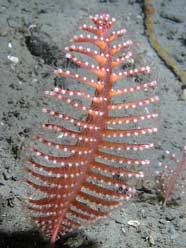
One group of sea pens have secondary polyps grouped into "polyp leaves,"giving these species a feather-like appearance, from which we get the common name as they look something like old-fashioned quill pens. (Photo: Kåre Telnes (www.seawater.no))
|
sea pen - a soft coral in the order Pennatulacea and subclass Alcyonaria. Sea pens are colonial octocorals which exhibits polyp dimorphism. One polyp grows very large, loses its tentacles and forms a central axis. The base of this primary polyp forms a bulb which may be expanded or contracted. The bulb is used to anchor the colony. Branching off this primary polyp are various secondary polyps. Some, called autozooids, are typical feeding polyps. Others, called siphonozooids, serve as intakes for water, which circulates within the colony and helps keep it upright. Calcareous spicules and frequently a central axial rod of calcium carbonate also provide support. One group of sea pens have secondary polyps grouped into "polyp leaves," giving these species a feather-like appearance, from which we get the common name as they look something like old-fashioned quill pens. Most species, however, do not have polyp leaves, and look more like clubs, umbrellas, or pinwheels |
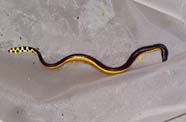
This sea snake was photographed and released during a 1998 cruise of the NOAA ship McARTHUR to South America.
|
sea snake - a member of the family Hydophiidae. Sea snakes are common in the Indo-Pacific. Related to cobras, these live-bearing reptiles are highly venomous but not aggressive by nature |
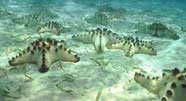
The horned sea star (Protoreaster nodosus) inhabits shallow water in the lagoon or back reef of Indo-Pacific coral reefs. (Photo: Teresa (Zubi) Zuberbühler) (www.starfish.ch)
|
sea star - an echinoderm characterized by radial symmetry, and usually with five arms (rays) radiating from a central body. Minute pincer-like structures on the arms, called pedicellaria, ensure that the surface of the arms stay free from algae. There are a few sea stars that have 6 or 7 arms, and some with even more. Injuries will also cause more arms to grow. The majority of sea stars are carnivorous and feed on sponges, bryozoans, ascidians and mollusks. Other are detritus feeders or scavengers. Some sea stars, for example the crown-of-thorns that feeds on coral polyps, are specialized feeders; also called "starfish" |
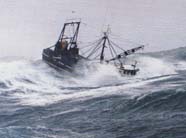
Fishing vessel battles through rough conditions (sea state). (Photo: NOAA/National Weather Service/Ocean Prediction Center)
|
sea state - a description of the sea surface with regard to wave action |
sea time - logged time spent at sea |
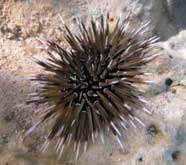
The rock boring sea urchin , Echinometra mathaei, lives in holes and depressions on rock in shallow areas. (Photo: Teresa (Zubi) Zuberbühler) (www.starfish.ch)
|
sea urchin - sea urchins are echinoderms in the class Echinoidea, that possess a hard calcareous shell (test) armed with spines, which may be long and pointed, or short and pointed, or dull. The spines are used for locomotion (along with tube feet), protection, and for trapping drifting food particulates, such as algae. Most sea urchins are algal grazers but some feed on sponges, ectoprocts and ascidians, and others on detritus. Sea urchins help to keep corals free of overgrowing algae |
sea wasp - a jellyfish in the cnidarian class Cubozoa. Also known as "box jellyfish," their stinging cells produce a lethal toxin capable of killing humans who come into contact with the sea wasp's tentacles. Sea wasps are found in the tropical Pacific Ocean from Australia to Hawaii. They are cube or box-shaped, hence the name "box jellyfish" |
SeaBat - a multibeam sonar system that provides high-resolution bathymetry and imagery data in real time for extremely detailed 3-D representation of underwater features and seabed conditions |
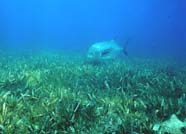
Seagrass bed.
|
seagrass - a flowering plant, complete with leaves, a rhizome (an underground, usually horizontally-oriented stem) and a root system. They are found in marine or estuarine waters. Most seagrass species are located in soft sediments. However, some species are attached directly to rocks with root hair adhesion. Seagrasses tend to develop extensive underwater meadows |
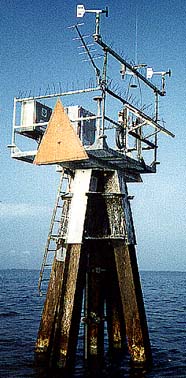
Coastal-Marine Automated Network (C-MAN) Station.
|
SEAKEYS - NOAA and the Florida Institute of Oceanography (FIO) supply daily and historical enhanced Coastal-Marine Automated Network (C-MAN) data via the SEAKEYS program. Since 1992, SEAKEYS has provided hourly data from up to seven meteorological and oceanographic monitoring stations situated throughout the Florida Keys National Marine Sanctuary and Florida Bay. These stations measure the usual C-MAN meteorological parameters, such as wind speed, gusts and barometric pressure, but are enhanced with oceanographic instruments measuring salinity, sea temperature, fluorometry and turbidity These data are collected and presented via email and the Web daily, and are supplied through a historical database on the Web. Unique software developed for SEAKEYS data operates in near real-time and provides alerts as to conditions conducive to natural events such as coral bleaching (Coral Reef Early Warning System [CREWS]), larval conch survival, and in the future, harmful algal blooms |
seamount - a submarine mountain, usually conical in shape and volcanic in origin, that rises 1000 meters or more above the sea floor. Some definitions of seamounts do not include the height criterion |
Seascape - a large, multiple-use marine area, defined scientifically and strategically, in which government authorities, private organizations, and other stakeholders cooperate to conserve the diversity and abundance of marine life and to promote human well-being. Seascapes typically have high biological diversity, ecological and economic connectivity, and aesthetic and cultural value. Seascapes may include government-authorized protected areas for addressing special management needs and provide an opportunity for government agencies to coordinate their efforts voluntarily to secure more effective regional management programs. Seascapes define places where conservation goals and human well-being can be secured through partnerships between governments, local communities, and non-government and private organizations |
seawall - a massive structure built along the shore to prevent erosion and damage by wave action |
seaward slope - the area of a barrier reef or atoll from the reef crest. It includes spurs, grooves, terraces, reef walls, etc. |
SeaWiFS - Sea-viewing Wide Field-of-view Sensor carried on the SeaStar satellite |
Secchi depth - the depth at which a Secchi disk disappears from view as it is lowered in water Secchi disk a white disk 20-30 cm in diameter, used as a qualitative way of measuring water clarity. It is lowered from a vessel and viewed from above the surface in full solar illumination to estimate the light attenuation in the water column. This is done empirically by relating the depth at which the disk disappears to the attenuation of light |
Second Law of Thermodynamics - each time energy is converted from one form to another, some of the energy is always degraded to a lower-quality, more dispersed, less useful form; no system can convert energy from one form to another useful form with 100 percent efficiency; energy cannot be transferred spontaneously from a cold body to a hot body. As a result of this fact, natural processes that involve energy transfer must have one direction, and all natural processes are irreversible. This law also predicts that the entropy of an isolated system always increases with time |
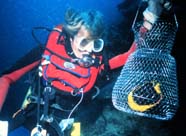
The second stage regulator is contained in this NOAA diver's mouthpiece. (Photo: NOAA/National Undersea Research Program)
|
second stage regulator - in scuba breathing equipment, the second stage regulator, which is attached to the mouthpiece, reduces the intermediate pressure from the first stage regulator (attached to the air tank) to that needed for comfortable breathing at depth |
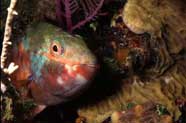
Secondary male stoplight parrotfish. Parrotfish can undergo sex reversals during their life history. (Photo: George Ryschkewitsch)
|
secondary male or female - a male or female that is the result of sex change. A secondary male would be derived from a protogynous female, in which there is a regression of the ovaries and a proliferation of testicular tissues. A secondary female would be derived from a protandrous male in which the female primary sex organs replace the testes |
secondary polyp - polymorphic polyps which grow as branches from the supporting primary polyp in colonial octocorals. These secondary polyps are specialized for feeding or water circulation within the colony |
secondary production - the production of living material per unit area (or volume) per unit time by herbivores. It is usually expressed as grams carbon per meter square per year |
secretion - the passage of a molecule from the inside of a cell through the cell membrane into the periplasmic or interstitial space, or the extracellular medium; the organic process of synthesizing and releasing some substance from the body of an organism |
secretory product - a functionally specialized substance, not a waste product, released from a gland or cell. Hormones, for example, are secretory products |
section - a thin slice of some biological material for examination under a microscope |
section, cross - sliced at right angles to the longitudinal axis of an organism or part |
section, oblique - sliced as a section that is neither parallel to the longitudinal axis nor at right angles to this axis of an organism or part |
section, saggital or longitudinal - sliced along or parallel to the longitudinal axis of an organism or part |
sedentary - not moving. Many organisms, both plants and animals, spend the majority of their lives in one place |
sedimentary rock - rock formed from sediments in ancient oceans, e.g., sandstone, limestone, and chalk. Sedimentary rocks can be changed by heat and pressure into metamorphic rocks; any rock resulting from the consolidation of sediment |
sediments - soil, sand, and minerals washed from land into water, usually after rain. They pile up in reservoirs, rivers, harbors, and coastal areas destroying habitats, and clouding the water so that sunlight cannot reach aquatic plants. Careless farming, mining, and building activities expose sediment materials, allowing them to wash off the land after rainfall |
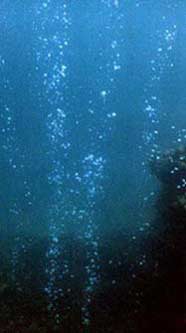
Methane bubbles that rise through the seabed sediments may escape gently at the seabed through discrete migration pathways and form seabed seeps (Project CRIMEA)
|
seep - a small area where water that may be of a different temperature and density flows from below the seafloor and rises slowly into the ocean; a spot where water that is flowing below the earth’s surface slowly oozes out to form a small pool or a spring abov |
seepage - the movement of water through a porous medium |
segmentation - in many animals, the body is divided into repeated subunits called segments, such as those in centipedes, insects, and annelid worms. Segmentation is the state of having or developing this type of body plan |
seine - a fish net that hangs vertically, with floats at the top and weights at the bottom |
Sekisei Lagoon - the largest coral reef in Japan, located almost at the southernmost end of the Ryukyu archipelago and designated as a part of Iriomote National Park. The Lagoon has a rich ecosystem and is a major source of coral larvae for distant reefs in the Ryukyu and Honshu Islands |
selective pressure - forces acting on populations that determine that some individuals are more reproductively successful or genetically fit than others, and contribute more descendants (or genes) to subsequent generations |
self-fertilization - when a sperm cell and ovum from the same organism fuse and form a zygote |
semelparity - the reproductive condition where individuals reproduce only once during their lifetime |
seminal receptacle - a sac that stores spermatozoa (sperm cells) prior to fertilization of an egg |
semipermeable membrane - a thin membranous barrier that permits passage of particles up to a certain size or of a special nature; also referred to as a 'differentially permeable membrane' |
semispecies - populations of a species that are completely isolated from one another but have not yet evolved into truly different species |
senescence - the aging process in mature individuals; the period near the end of an organism's life cycle |
senior homonym - in taxonomy, the older, or earliest established taxonomic name |
senior synonym - in taxonomy, the older name of two synonyms |
sens. lat. - in the broad sense (sensu lato) |
sensor - a device that receives electromagnetic radiation and converts it into a signal that can be recorded and displayed as numerical data or as an image |
sensory receptor - a neurological structure specialized to respond to stimuli and changes in the internal or external environment of an organism. Sensory receptors consist of neuron endings and specialized cells in close contact with neurons |
sepsis - the presence in the blood or other tissues of pathogenic microorganisms or their toxins; the condition associated with such presence |
septate shell - a shell divided into smaller chambers, as in the chambered nautilus (Cephalopoda-Mollusca) |
septum - a thin partition |
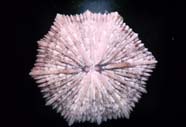
Skeleton of a coral polyp. Notice the septa radially arranged around a central axis.
|
septum (pl. septa) - the skeletal plate that projects into the calyx from the theca. Septa may be subdivided into primary, secondary, and tertiary structures |
septum, primary - in corallites, full partitions that separate two sets of mesenterial pairs |
septum, secondary - in corallites, partial partitions that separate mesenteries within a mesenterial pair |
sequence - the order of neighboring amino acids in a protein or the purine and pyrimidine bases in DNA or RNA |
sequencing - analytical procedures for the determination of the sequential order of amino acids in a polypeptide chain or nucleotides in a DNA or RNA molecule |
sequential hermaphrodite - a form of hermaphroditism where individuals can change sex, but the sexes are separate |
seratonin receptor - a receptor for the neurotransmitter seratonin (5-hydroxytryptamine or 5-HT). The receptors are located on the cell membrane of nerve cells (neurons) and other cell types, such as smooth muscle cells |
sere - the series of communities that follow one another in a natural succession, as in the change from a bare field to a mature forest |
serehd - the serehd or Pohnpei Lory (trichoglossus rubiginosus) is a small, brightly colored parrot indigenous to Pohnpei Island in the Federated States of Micronesia. It is the state bird of Pohnpei |
serial homology - representative or repetitive relation in the segments of the same organism, as in the lobster, where the parts follow each other in a linear series; repeated structures within an organism that have similar developmental origins |
serial spawning - spawning more than once in a season |
series - in taxonomy, the sample available for study |
serosa - a serous membrane |
serotonergic - a term that means "related to the neurotransmitter serotonin". A synapse is serotonergic if it uses serotonin as its neurotransmitter. A substance is serotonergic if it is capable of producing, altering, or releasing serotonin |
serotonin - a neurotransmitter (5-hydroxytryptamine, 5-HT) necessary for communication between nerve cells |
serotonin receptor agonist - a compound that activates serotonin receptors, mimicking the effect of the neurotransmitter serotonin |
serotonin receptor antagonist - a chemical that acts to inhibit serotonin receptors |
serous membrane - an epithelial and connective tissue membrane that lines body cavities and covers visceral organs within these cavities. Epithelial cells constituting this membrane secrete a fluid (serous fluid) to the membrane's surface, which keeps the membrane moistened; also called "serosa" |
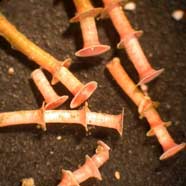
Tiny tubes of a tube-building serpulid worm. (Photo: NOAA)
|
serpulid worm - a marine polychaete worm in the family Serpulidae which secretes and lives in a rigid calcareous tube |
serrate - saw-like; notched |
server - a computer which is designed to be accessed by many other computers. Servers can be attached to local area networks and/or be hooked up to the internet. With the proper software and connections, servers can control the distribution of email, store World Wide Web documents, and provide access to files that are shared by many users |
sesquiterpene isocyanides - a class of toxic chemicals which act as defensive chemical secretions in some sea slugs |
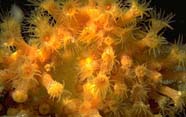
A sessile colonial anemone (Epizoanthus americanus) living in Gray's Reef off Sapelo Island, GA.
|
sessile - describes an immobile organism because of its attachment to a substrate. The term has also been applied to organisms, such as anemones, that move very slowly |
seston - minute particulate material moving in water that is composed of both living organisms, such as plankton, and non-living matter such as plant debris and suspended soil particles |
set - in mathematics, a collection of things without regard to their order |
seta - a cuticular hair arising from the outside of the exoskeleton of an invertebrate |
setiform - bristle-like; brush-like |
sewage - the total of organic waste and waste water generated by residential and commercial establishments |
sex chromosome - a heteromorphic chromosome that plays a role in sex determination, such as the X and Y chromosomes, whose distribution in a zygote determines the sex of the organism; a chromosome whose DNA determines sexual characteristics in females (X)-and males (Y) |
sex inversion - change of sex naturally or after steroid hormone application; also called "sex reversal" |
sex ratio - the relative number of males and females in a population. |
sex-linked gene - a gene coded on a sex chromosome, such as the X-chromosome-linked genes |

Sexual dichromatism in the freshwater southeast Asian dwarf gourami, Colisa lalia. The male is to the left of the female.
|
sexual dichromatism - pertaining to differences in color and color pattern between the sexes of a particular species |
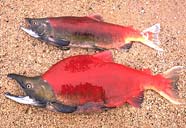
Female (above) and male (below) sockeye salmon (Oncorhynchus nerka) show extreme sexual dimorphism (color, male hump).
|
sexual dimorphism - pertains to systematic differences between males and females. The two sexes are markedly dissimilar in appearance |
shakedown dive - a practice scuba dive to make sure that the equipment works and the divers understand procedures |
shape file - a set of files that contain a set of points, arcs, or polygons (or features) that hold tabular data and a spatial location. This file format is used in ArcView software |
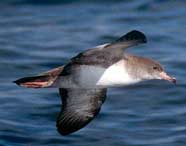
The pink-footed shearwater (Puffinus creatopus) occurs primarily in the eastern Pacific (Photo: Michael Donahue/USGS)
|
shearwater - any of about 25 species of medium-sized, long-winged seabirds in the family Procellariidae. Those in the genus Procellaria are usually called 'petrel' |
shelf break - nearshore bathymetry characterized by rapid and substantial increases in depth that are continuous with the deeper parts of the ocean |
shelf escarpment - the edge of the bank/shelf where depth increases rapidly into deep oceanic water |
shelf reef - a reef that forms on the continental shelf of large land masses |
shelf-edge reef - a synonym of ribbon reef |
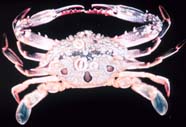
Edible crabs, shrimp, lobsters, crayfish, clams, mussels, scallops, and oysters are considered shellfish.
|
shellfish - a term that includes both molluscs, such as clams and oysters, and crustaceans, such as lobsters and shrimp |
shifting baseline - refers to the incremental lowering of environmental standards, in which each new generation lacks knowledge of how the environment used to be, redefines what is "natural," according to personal experience, and sets the stage for the next generation's shifting baseline |
shoal - a submerged expanse of coral reef, surrounded by deep water, which does not form a part of a barrier or fringing reef |
shoal (biol.) - a social group of fishes of the same species that are not always similar in size or equal in social status. The shoal does not usually move in a highly coordinated fashion, as does a school. Shoals are typically found in shallow water or at the surface. Some consider shoals to be schools in shallow water |
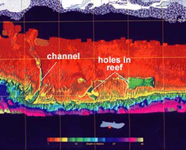
SHOALS imagery of the South Moloka'i reef tract shows the position of a distinctive channel that crosses the reef and a large hole in the reef. The large hole is shown below in oblique view. The origin of features such as this one is being investigated by USGS scientists. (Photo: U.S. Geolgical Survey)
|
SHOALS (Scanning Hydrographic Operational Airborne Lidar Survey) - SHOALS is a laser-based scanning LIDAR bathymeter which collects high-resolution bathymetric data in shallow, offshore areas. Map products provide a view of sea-floor topography. In areas with coral reefs, this includes not only the top surface of the reef but also associated channels and sand flats |

This sand piper is foraging for food on a beach. (Photo: Mary Hollinger/NOAA)
|
shore bird - any of various species of bird, such as the sandpiper, plover, or snipe, that frequents the shores of coastal or inland waters |
shore reef - a synonym of fringing reef |
shore species - marine fishes that are always found near the shore |
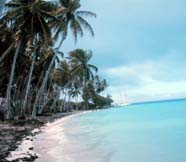
Shoreline of Fanning Island in the South Pacific.
|
shoreline - the line separating land and water. It fluctuates as water rises and falls |
shoreline - the intersection of the land, including man-made waterfront structures, with the water surface. The shoreline depicted on NOS maps and charts represents the line of contact between the land and a selected water elevation. In areas affected by tidal fluctuations, the shoreline is the interpreted mean high water line. In confined coastal water of diminished tidal influence, the mean water level line may be used. In non-tidal waters, the line represents the land/water interface at the time of survey. In areas where the land is obscured by marsh grass, cypress or similar marine vegetation, the actual shoreline can not be accurately represented. Instead, the outer limit line of the vegetation area is delineated (where it would appear to the mariner as the shoreline) and is referred to as the apparent shoreline |
shower - precipitation that is intermittent in time, space or intensity |
sibling species - closely-related species that are nearly morphologically indistinguishable |
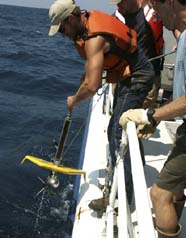
Deployment of the side scan sonar tow vehicle, also called a ‘fish’. (Photo: NOAA)
|
side scan sonar - sonar designed to look sideways and at a downward angle from both sides of a towed unit, called a towfish. The bottom and any objects in the water above the bottom reflect sound waves back to the towed array. An image is produced fom this information |
sieve plate - a structure in echinoderms through which water can flow in either direction between the water vascular system and the surrounding ocean; also known as the madreporite |
sigma - an informal name for the standard deviation. The lower case Greek letter sigma (s) is the usual symbol for the standard deviation |
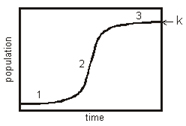
This sigmoid (or s-shaped) curve is characteristic of many growth situations.
|
sigmoid growth - a growth rate trend characterized by an elongated S–shaped, or sigmoid curve. It is typical of population growth rate trends which begin rapidly at an exponential rate but slow as limiting factors are encountered until a limit is approached asymptotically |
sign - evidence as is perceptible to the examiner, as opposed to the subjective sensations of the patient (symptom). Sign, not symptom should be used to describe lesions or conditions observed in coral, as the ability to convey sensations is not a characteristic of coral |
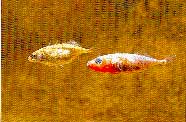
The red belly of the male three-spined stickleback (Gasterosteus aculeatus) acts as a sign stimulus to "release" aggressive behavior in a rival male or courtship behavior in a female. (Photo: Mid Northants trout Association/Kevin Rowley)
|
sign stimulus - the effective part of an action or object that triggers a highly stereotyped innate behavior (or fixed action pattern) in an animal by means of a hypothetical neural pathway called the innate releasing mechanism (IRM) |
signal transduction pathway - a series of sequential events by which a signal outside of a cell causes a functional change inside the cell. Signal transduction pathways transfer the signal through a series of intermediate molecules until final regulatory molecules are modified in response to the signal. Signal transduction pathways are important means of regulating numerous cellular functions in response to changes in the cell's chemical or physical environment |
signal-to-noise ratio - the difference between the source level of a sound signal from a source and the source level of the background noise |
signalment - in pathology, a detailed description of an organism whose health is being examined. It includes physical characteristics, taxonomic identification, and specimen collection information |
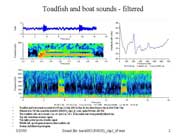
The signature sound of a toadfish.
|
signature sound - a unique sound that is associated with a specific sound source |
significance level (level of significance) - in statistics, the probability of a false rejection of the null hypothesis in a statistical test |
Sikes Act - passed in 1960, and amended several times, the Sikes Act authorizes the Secretary of Defense to develop cooperative plans for conservation and rehabilitation programs on military reservations and to establish outdoor recreation facilities. The Act also provides for the Secretaries of Agriculture and the Interior to develop cooperative plans for conservation and rehabilitation programs on public lands under their jurisdiction. Some coral reefs are affected by this Act |
siliceous - composed of silicon or primarily of silicon |
sill - the lowest point on a submarine ridge or saddle at a relatively shallow depth, separating a basin from an adjacent sea or another basin |
sill reef - a synonym of ribbon reef |
silt curtain - a temporary impenetrable barrier of flexible geotextile material used to contain sediments within a defined zone in the aquatic environment. This curtain is weighted at the bottom to achieve closure while supported at the top through a flotation system; also called a "turbidity curtain" |
simple - not divided or branched |
simultaneous hermaphrodite - a form of hermaphroditism where individuals simultaneously possess functional testes and ovaries, and can release either male or female gametes during spawning |
single nucleotide polymorphism (SNP) - a SNP (pronounced "snip") is a small genetic change, or variation, that can occur within an organism's DNA sequence. The genetic code is specified by the four nucleotides: adenine, cytosine, thymine, and guanine. SNP variation occurs when a single nucleotide, such as adenine, replaces one of the other three nucleotides. SNPs found within a coding sequence are of particular interest to researchers because they are more likely to alter the biological function of a protein. Because of the recent advances in technology, coupled with the unique ability of these genetic variations to facilitate gene identification, there has been a heightened activities of SNP discovery and detection |
single-stranded - a term used to describe nucleic acid molecules consisting of only one polynucleotide chain. The genomes of certain phages are single-stranded DNA molecules; rRNA, mRNA and trNA are all single-stranded nucleic acids |
single-stranded DNA - a single chain of deoxyribonucleotides that occurs in some bacteria and viruses. It usually exists as a covalently closed circle |
sinistral - left, as opposed to dextral, or right |
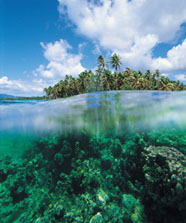
The marine environment is a sink for many nutrients. (Photo: copyright Digital Vision Ltd.)
|
sink - a process or place that acts to absorb or remove energy or a substance from a system. The ocean, for example, is a sink for carbon dioxide |
sink habitat - a habitat in which reproduction is insufficient to balance mortality. The population can persist in the habitat only by being a net importer of individuals |
sink population - a population that occupies habitat types in which reproductive output is inadequate to maintain local population levels. The population may be replenished by emigrants from source populations |
sink population or species - a population or species that cannot reproduce fast enough to replace themselves. Sink populations or species are present only because immigrants compensate for excess deaths in the area. Eventually, sink species will disappear from isolated areas |
sinkhole - a depression formed in an area either by dissolving of the surface limestone or by collapse of underlying cavities |
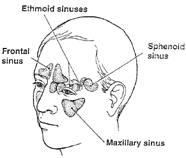
The sinuses are a group of 4 pairs of air filled spaces in the head. They are called the ethmoid, maxillary, sphenoid, and frontal sinuses. They warm and humidify the air as one breathes. They also trap and filter organic and non-organic particles from the air, such as bacteria, spores, and dust. (Graphic: Cystic Fibrosis Center at Stanford University)
|
sinus - one of several air spaces within the skull that are in contact with ambient pressure through nasal passage openings in the posterior pharynx; a sac-like space |
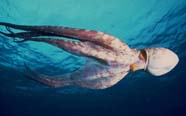
An octopus rapidly swimming by forcibly expelling water through the tubular siphon projecting from the head. (Photo: Jeff Jeffords)
|
siphon - an opening in molluscs or in urochordates (tunicates) which draws water into the body cavity. In many molluscs, such as octopods and squids, the siphon may be used to forcibly expel water, providing a means of propulsion |

A microscopic section showing the siphonoglyph of a sea anemone from Chile, Anemonia alicemartinae (Siphonoglyph (Si) with "reticulated pads" (Rp);Ci: cilia; M: mesoglea; Pm: pair of perfect mesenteries). (Photo:V.Häussermann & G.Försterra/U.Frankfort)
|
siphonoglyph - a groove in the pharynx of some cnidarians that is lined with cilia which pump water into the animal's gastrovascular cavity.This water current inflates the body, circulates fluids, and provides a volume of water to act as a hydrostatic skeleton |
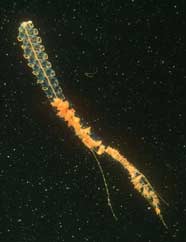
Siphonophores are actually colonies of individuals, each specialized for different functions such as swimming, feeding and reproduction. (Photo courtesy of Marsh Youngbluth and NOAA Ocean Explorer)
|
siphonophore - siphonophores are "colonial jellyfish" which have swimming bells at the top, and tentacles with stinging cells below that help them to catch their prey. Each individual of the colony is specialized for a different function, such as swimming, feeding and reproduction. Some siphonophores can be more than 10 meters long. They are in the phylum Cnidaria, class Hydrozoa and order Siphonophora |
siphonozooid - a specialized polyp found in colonial soft corals, such as sea pens and sea pansies, which functions as as intake for water, which circulates within the colony and helps keep it upright |
siphosome - in hydrozoans, the region of the siphonophore colony that bears all zooids except the nectophores |
siphuncle - a tubelike structure in the body of a shelled cephalopod, such as the chambered nautilus, extending through the partitions of each chamber of the septate shell; the term is also used to describe tubular structures that direct water flow, or as a feeding siphon of several different kinds of invertebrates |
Sipuncula - an animal phylum that contains the peanut or starworms. They are small, non-segmented benthic animals (they are not worms), some of which live in coral crevices, empty mollusk shells or marine worm tubes. Several species bore into coralline rock |
siRNA (short interfering RNA) - a 21-23 nucleotide-long RNA that mediates messenger RNA (mRNA) catalysis; used in gene suppression |
sister group - a taxon thought to be the closest relative of a given taxon, exclusive of the ancestral species of both taxa |
sister taxa - two taxa that are more closely related to each other than either is to a third taxon; monophyletic taxa that are each other’s closest relatives, i.e., they share an immediate common ancestral species |
site fidelity - the behavior of certain animals whereby they return, reproductive season after reproductive season, to the same breeding site |
sixteen S RNA gene (16S rRNA gene or 16S ribosomal RNA gene) - a particular kind of RNA used as a molecular tool to extract and compare bits of a particular kind of RNA from samples in order to determine if previously known or new microorganisms are present in a particular environment. This technique is widely used as a biomarker and for microbial ecology studies. The 16S rRNA gene is very short, just 1,542 nucleotide bases, and can be quickly and cheaply copied and sequenced |
skeletal density - certain massive coral species (e.g. Porites) exhibit annual variations in the density of their calcium carbonate (CaCO3) skeleton, similar to tree rings. The annual density bands are revealed when slices of coral skeleton are X-rayed |
skeleton - a supportive or protective structure or framework of an animal, a plant, or part of an animal or plant. In animals it is an external (exoskeleton) or internal (endoskeleton) support structure, against which the force of muscles acts. Vertebrates have a skeleton of bone or cartilage; arthropods have one made of chitin; corals have one of calcium carbonate: sponges have a mass of spicules; many other invertebrates use a hydrostatic skeleton, which is an incompressible fluid-filled region of their body. In plants, the skeleton may be a rigid protective covering, as in the shell of a diatom, or the vascular system of a vascular plant |
skerry - a low-lying rocky island or reef, often without terrestrial vegetation, and frequently swept by waves |
skewness - A measure of the degree to which a distribution is asymmetrical |
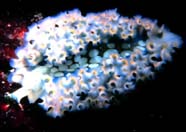
Lettuce sea slug (tridachia crispata) from the Florida Keys National Marine Sanctuary.
|
slug - a pulmonate or opisthobranch gastropod in which the shell is absent, or reduced and buried within the mantle |
slurp gun - a tube-shaped fish collecting device that operates somewhat like a syringe by sucking up fish or other specimens |
smooth - describes a surface without projections; glabrous |

Large aggregations of gray snapper, Lutjanus griseus, are frequently observed among coral reefs, rocky areas, estuaries, and mangrove habitats. (Illustration: FAO Species Catalogue )
|
snapper - any species of bony fishes in the family Lutjanidae. Snappers are found in the tropical and subtropical regions of the Atlantic, Pacific, and Indian oceans. A few are estuarine to entirely freshwater. Many species are popular food and game fishes. Some ha |
sneaky male - a small, non-dominant male fish which attempts to fertilize eggs by darting suddenly onto the nest site; also called "sneaker" |

This swimmer is breathing through a snorkle. (Photo: Courtesy of Cayman Islands Department of Tourism)
|
snorkel - a breathing device that allows a swimmer to breathe while face down in the water. It consists of a bent plastic or rubber tube fitting into a swimmer's mouth and extending above the surface |
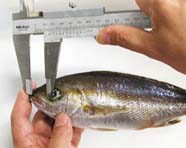
Measuring the snout length of a fish.
|
snout - the portion of the head that is just anterior to the eyes |
social behavior - any kind of interaction between two or more animals, usually between animals of the same species |
social group - a small population in which the individuals are bound together in relatively stable patterns of interaction and in some ways depend upon each other for its survival |
social rank - in animal behavior, the position an animal holds in a social group of the same species |
sociobiology - the systematic study of the biological basis of all social behavior. Sociobiology works entirely within the neo-Darwinist evolutionary paradigm in which “each phenomenon is weighed for its adaptive significance and then related to the basic principles of population genetics |
SocMon Guidelines - SocMon is a set of guidelines for establishing a socioeconomic monitoring program at a coastal management site. The guidelines provide a prioritized list of socioeconomic variables useful to coastal managers as well as the questions for data collection and the tables for data analysis. It is expected that the guidelines will be tailored to each site’s needs. SocMon is a companion to the GCRMN Socioeconomic Manual for Coral Reef Management (GCRMN Manual) |
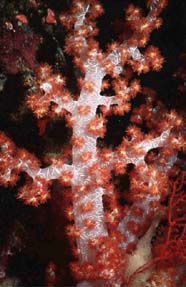
Beautiful specimen of soft coral
|
soft coral - common name for species of the anthozoan order Alcyonacea of the subclass Octocorallia. In contrast to the hard or stony corals, most soft corals do not possess a massive external skeleton |
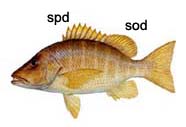
The spiny dorsal (spd) and soft dorsal (sod) fin of a schoolmaster snapper. (Photo: Fishing-Florida.com)
|
soft dorsal - a dorsal fin containing only soft rays, or the soft-rayed hind part of the dorsal fin, if both spines and soft rays are present (as in squirrelfish) |
sol - a liquid colloidal dispersion; a cytoplasmic phase (the other phase is a gel) |
solar energy - electromagnetic energy from the Sun |
solar radiation - the amount of radiation or energy received from the sun at any given point |
solar year - the time it takes the Earth to make one orbit around the Sun; approximately 365.2422 days |
soleiform - slipper-shaped |
solenium - in octocorals, a small gastrodermis-lined canal which penetrates the coenenchyme to join a network of other solenia which fuse with the larger gastrovascular canals to connect the gastrovascular cavities of the polyps |
solitary coral - coral polyps can be solitary or colonial. Solitary forms remain as a single individual polyp and one corallite |
solstice - either of the two times of the year when the sun is the greatest distance from the celestial equator, occurring about June 22 and December 22 |
solute - the chemical substances dissolved in a solution, such as salts in seawater |
solution - a liquid mixture in which the minor component, the solute, is uniformly distributed within the major component, the solvent |
solvent - the liquid in which a solute is dissolved to form a solution |
solvolysis - a reaction with a solvent involving the rupture of one or more bonds in the reacting solute |
somatic mutation - a change in the genetic structure that can occur in any of the cells of the body except the reproductive cells, and therefore is neither inherited nor passed to offspring. Also called an 'acquired mutation' |
somite - a segmental mass of mesoderm in the vertebrate embryo, occurring in pairs along the notochord, and developing into skeletal muscles and vertebrae; in some invertebrates, the term "somite" refers to a metamere |
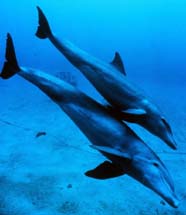
Mother and juvenile bottlenose dolphins (Tursiops truncatus). Dolphins and whales can use echolocation to help navigate.
|
sonar - SONAR is an acronym for "sound navigation and ranging." Active sonar describes an apparatus that transmits high frequency sound waves in water and registers the vibrations reflected back from an object. Passive sonars listen without transmitting. They are usually military (although a few are scientific). Some marine animals, such as whales and dolphins, use echolocation systems similar to active sonar to locate predators and prey |
sonic muscle - in fishes, a muscle(s) associated with the swimbladder, which when contracted against the swimbladder wall, produces sounds associated with territorial and reproductive behavior |
soniferous - sound producing |

Sonograph of a crested warbler. Time is on the x-axis and frequency (pitch) is on the y-axis. The sonograph shows discrete pulses of sound over time. Loudness (amplitude) is indicated by the darkness of the pulse.
|
sonograph - a hard copy display of sound data generated either in real time or from recorded data. Also known as a sonogram |
sorus - a group or cluster of sporangia |
sound - a longitudinal pressure wave produced by the vibration of molecules in an elastic medium, which can be a liquid, solid, or gas. As the molecules are set in motion, they radiate outwards, colliding into other molecules (compression), then move apart farther than their equilibrium distance (rarefaction), travelling in this manner until they stimulate a sound receptor organ, such as an ear or tactile organ.The receptor translates the mechanical energy of the pressure wave to electrochemical energy of a nervous system, which stimulates a hearing or tactile sensation in the receiving organism |
source DNA - the DNA from an organism that contains a target gene. This DNA is used as starting material in a cloning experiment |
source habitat - a habitat that is a net exporter of individuals |
source population - a population that occupies a habitat suitable for reproduction, in which the quantity of offspring results in a population that exceeds the carrying capacity of the local habitat, thereby promoting dispersal |
source species - a species whose births exceed deaths in an area. Source species can provide individuals to populate other areas |
Southern Cross - a small conspicuous constellation in the southern hemisphere in the Milky Way near Centaurus |
Southern Oscillation - a large-scale atmospheric and hydrospheric fluctuation centered in the equatorial Pacific Ocean. It exhibits a nearly annual pressure anomaly, alternatively high over the Indian Ocean and high over the South Pacific. Its period is slightly variable, averaging 2.33 years. The variation in pressure is accompanied by variations in wind strengths, ocean currents, sea-surface temperatures, and precipitation in the surrounding areas. El Niño occurrences are associated with the phenomenon |
sovereign - an independent or non-independent jurisdiction which itself possesses or whose people possess in their own right the jurisdiction's supreme authority, regardless of the jurisdiction's or people's current ability to exercise that authority |
sp(p) - abbreviation for species, singular and plural |
spacer region - a sequence of nucleotides in a DNA molecule between coding genes |
spat - tiny single corallites that form immediately after the metamorphosis of planula larvae |
spathiform - resembling a rounded pole in form |
spatial data - information about the location and shape of, and relationships among, geographic features, usually stored as coordinates and topology |
spatial index - the ratio of reef surface contour to linear distance. As part of a monitoring program employing a chain transect protocol, the spatial index provides a way to quantify changes in the topographical complexity of the reef |
spatial index - as pertaining to coral reef ecosystems, the ratio of reef surface contour distance to linear distance. A high index indicates a surface of high rugosity |
spatulate - spoon or broadly blade-shaped |

Fish spawn (egg mass) deposited on a coral. (Photo: Kev Jacklin)
|
spawn - to produce or deposit eggs; the eggs of aquatic animals; the mass of eggs deposited by fishes, amphibians or mollusks; offspring in great numbers or masses; to give forth young in large numbers |
spawning - in corals, the release of gametes into the water |
specialist - an organism which has adopted a lifestyle or niche specific to a particular set of conditions |
specialist species - species that have a relatively narrow ecological niche |
speciation - the evolutionary process that gives rise to a new species |
species - in sexually reproducing organisms, a species is a group of genetically related organisms, usually similar in physical appearance, that actually or potentially interbreed and are reproductively isolated from other groups |
species aggregate - a group of species that are morphologically similar and therefore difficult to identify |
species at risk - an extirpated, endangered or threatened species or a species of special concern (formerly called "vulnerable") |
species diversity - the number of different species in an area and their relative abundance |
species group - a group of species considered together, often because they are difficult to differentiate without detailed examination, e.g., very similar species; a group of closely related species; a superspecies |
species of concern - species about which NOAA's National Marine Fisheries Service (NMFS) has some concerns regarding status and threats, but for which insufficient information is available to indicate a need to list the species under the Endangered Species Act |
species of special concern - species which are particularly sensitive to human activities or natural events but not endangered or threatened. Special concern was formally referred to as "vulnerable" |
species recovery plan - a plan for restoration of an endangered species through protection, habitat management, captive breeding, disease control, or other techniques that increase populations and encourage survival |
species richness - the number of species in an area or biological collection |
specific action potential - instinctive behavior, triggered by internal chemico-physiological factors that builds to a certain level, and allows the behavior to take place. This build up is called the specific action potential. It is responsible for an animal performing one behavior in preference to other behaviors |
specific name - the second name in a binomen and in a trinomen |
speciose - having many species |
spectrometer - an instrument for measuring wavelengths of light of a spectrum |
spectrophotometer - an instrument for measuring speed of different parts of light spectrum |
spectroradiometer - a radiometer that measures radiant energy as a function of wavelength |
spermary - an organ in which male gametes (sperm cells) are produced. The term is usually used in reference to invertebrate animals |
spermatangium - the male gamete-producing reproductive organ in certain algae |
spermatium - a non-motile male gamete produced by a spermatangium in red algae |
spermatocyte - a male gametocyte, which in the meiotic process, develops into four haploid spermatids, each of which develop into a spermatozoan |
spermatogenesis - the process of sperm cell (spermatozoa) development in male animals, in which the diploid number of chromosomes is reduced by half to the haploid number in the spermatozoa |
spermatophore - a packet containing sperm cells which is produced by the male genital system for transfer to the female. This method of sperm transfer is found in some vertebrates (salamanders) as well as invertebrates |
spermatozoan - a sperm cell; the male reproductive cell; the male gamete |
spicule - one of the numerous small to minute calcareous or siliceous bodies occurring in and serving to stiffen and support the tissues of various invertebrates, as in the majority of sponges, alyconarians, and many radiolarians, holothurians and compound ascidians |
spicule - minute, hard, needle-like or sharp-pointed processes or projections |
spinate - spine-like or composed of spines |
spine - a sharp hard bony structure on the skeleton or skin. Body spines serve as predator deterrents; a usually stiff, sharp, dermal rod which supports a fin in fishes |
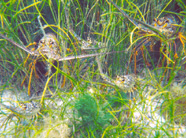
Spiny lobsters in a seagrass bed.
|
spiny lobster - a crustacean of the Family Palinuridae; it lacks large claws and has a flexible, leathery tail fan |
spiracle - one of the external openings communicating with the air tubes (tracheae) or book lungs of certain arthropods; a tubular opening, formed from the modified first gill cleft, communicating with the gill cavity of certain ganoid (e.g., gar pike, bowfin) and all elasmobranch fishes |
spiral cleavage - a developing embryo has spiral cleavage if, as it undergoes cleavage and changes from a four-cell embryo to an eight-cell embryo, the cells divide at slight angles to one another, so that the none of the four cells in one plane of the eight-cell stage is directly over a cell in the other plane. Spiral cleavage is characteristic of protostomes |
spirocyst - an anthozoan cnida structured as a thin, single walled capsule containing a long, sticky, spirally coiled, unarmed tubule of uniform diameter |
spirocyte - a cell in anthozoans that produces a spirocyst |
spirotele - a type of nematocyst |
spit - a stretch of sand, attached to the land at one end, and extending out into the sea |
splicing - the removal of introns and joining of exons to form a continuous coding sequence in RNA |
split spawning - spawning occurring over consecutive nights or consecutive lunar cycles within a reef |
splitter - refers to a taxonomist who focuses more on small differences among taxa, emphasizing minor variation among individuals, and who tends to recognize more taxa |
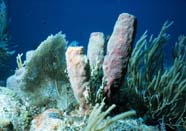
Tube sponges (Phylum Porifera)with sea fans (gorgonia) in background.
|
sponge - a multicellular animal (metazoa) below the tissue grade of construction. Sponges belong to the phylum Porifera. There are approximately 5,000 living species classified in three distinct groups, the Hexactinellida (glass sponges), the Demospongia, and the Calcarea (calcareous sponges). They are important components of a coral reef ecosystem |
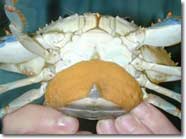
Depending on the size of the female, female blue crabs carry and release 800,000 to 8,000,000 eggs (Photo: Smithsonian Environmental Research Center)
|
sponge (2) - the egg mass of a female crab, which she carries attached to long "hairs" on her pleopods |
spongidines A-D - an antiinflammatory drug derived from marine sponges in the genus Spongia |
spongin - a fibrous horny protein that forms the skeletal framework of some sponges |
spongistatin - a marine pharmaceutical, extracted from the marine sponge Hyrtios erecta, which has broad-spectrum antifungal activity. It interferes with microtubule activity, hence the disruption of the cell division process (mitosis) |
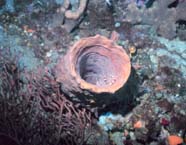
The central cavity of this sponge is the spongocoel. Note the banded shrimp in the spongocoel. (Photo: Dr. Anthony Picciolo)
|
spongocoel - the central body cavity of sponges, which opens to the outside by way of the osculum. |
spongocyte - a cell that secretes spongin fibers in sponges |
spontaneous process - a process which requires no influence from outside the system to proceed; a process which can proceed in an isolated system; in chemistry, a spontaneous process is one which occurs with the system releasing free energy in some form (often, but not always, heat) and moving to a lower energy (hence more thermodynamically stable) state |
sporangium - an organ containing or producing spores in some algae and fungi |
spore - a small reproductive cell produced by certain bacteria, algae, fungi and nonflowering plants. Spores contain at least one genome and are highly resistant to heat excess and dehydration |
sporophyll - a fertile blade in attached brown algae |
sporosac - a reduced gonophore of a hydromedusan that does not develop into free medusae, but remains attached and produces the gametes |
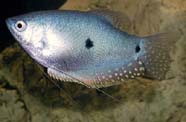
This female three-spotted gourami, trichogaster trichopterus, gets its common name from the conspicuous spots on its flank and caudal peduncle. The third "spot" is the eye. (Photo: Miguel Pais)
|
spot - a circular area of pigment |
spur and groove - a system of shallow ridges (spurs) separated by deep channels (grooves) oriented perpendicular to the reef crest and extending down the upper seaward slope |
spyhopping - behavior of a whale when raising the head vertically out of the water, usually while stationary, then sinking below the surface without much splash |
SQL (Structured Query Language) - a specialized language for sending queries to databases |
squall - a brief sudden and violent wind storm, often accompanied by rain or snow |
squall line - any nonfrontal line or band of active thunderstorms |

simple squamous epithelium, only one cell layer thick, under high power (Photo: K. Wynne/Tyler Junior College)
|
squamous epithelium - an epithelium consisting of one or more cell layers, the most superficial of which is composed of flat, scalelike or platelike cells |
squeeze - pain or discomfort in an enclosed space (sinuses, middle ears, inside a face mask) experienced by scuba divers on descent and ascent, caused by barotrauma to the affected area |
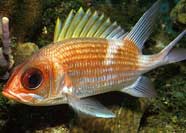
The squirrelfish, Holocentrus adscensionis, on a reef at Little Cayman Island (Photo:Mary Lou Frost)
|
squirrelfish - a bony fish in the family Holocentridae. Squirrelfishes are small, brightly colored spiny-finned fishes, commonly found living on coral reefs. Most squirrelfishes are reddish in color mixed with silver and white. All species have large eyes. During the day they are usually found hiding in crevices or beneath ledges. They are crepuscular species, most active at low light levels and at night |
SST (Sea Surface Temperature) - the temperature of the layer of seawater (approximately 0.5 m deep) nearest the atmosphere |
stability - in ecological terms, a dynamic equilibrium among the physical and biological factors in an ecosystem or a community; relative homeostasis; unchanging with time. This can be a static state, where nothing changes or a steady state where resource flows occur |
stable isotope - an isotope of a chemical element which is not spontaneously radioactive. Elements can exist in both stable and unstable (radioactive) forms. Most elements of biological interest (including C, H, O, N, and S) have two or more stable isotopes, with the lightest of these present in much greater abundance than the others. Among stable isotopes the most useful as biological tracers are the heavy isotopes of carbon and nitrogen. These two elements are found in the earth, the atmosphere, and all organisms |
stakeholder - an individual or group with an interest in the success of an organization in delivering intended results and maintaining the viability of the organization's products and services. Stakeholders influence programs, products, and services |
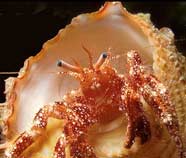
A red and white hermit crab (Dardanus venosus) illustrates stalked eyes in some crustaceans (Photo:Mary Lou Frost)
|
stalked eye - an eye carried on the end of a stalk or peduncle |
standard deviation - a measure of the spread or dispersion of a set of data. It is calculated by taking the square root of the variance |
standard error of the mean - the standard deviation divided by the square root of the sample size. It is the standard deviation of a sample of means |
standing stock - the total mass of organisms comprising all or part of a population or other specified group or within a given area; measured as volume, mass, or energy; biomass |
starboard - the right side of a vessel to someone facing the bow or front |
start codon - the set of three nucleotides in an mRNA molecule with which the ribosome starts the process of translation. The start codon sets the reading frame for translation. The most commonly used start codon is AUG, which is decoded as methionine in eukaryotes, and as N-formylmethionine in prokaryotes; also called 'initiator codon' |
stasipatric speciation - instantaneous speciation caused by polyploidy |
statin - any of a class of drugs that lower the amount of cholesterol in the blood by inhibiting an enzyme involved in its biosynthesis |
statistic - an estimate based on a sample or samples of a population, providing an indication of the true population parameter |
statistical analysis - the application of probability theory to quantified descriptive data |
statistical bias - in statistics, a difference between the expected value of an estimator and the population parameter being estimated |
statocyst - a sensory organ possessed by many invertebrates for the perception of gravity, thus body orientation and balance. Statocysts are found in many invertebrates. Each one has a cavity lined with sensory cells and contains a statolith |
statolith - a sand grain or a calcium carbonate granule or other hard secreted substance, found in the cavity of a statocyst. Under the influence of gravity, a statolith makes contact with the lining of the cavity, thereby stimulating sensory cells that line it |
status and trends analysis - a monitoring program designed to evaluate the current condition of physical and biological features found in an ecosystem and to detect changes that may occur over time. |
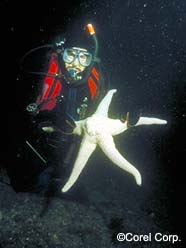
The diver is holding a stellate-shaped starfish. (Photo: Copyright Corel Corp.)
|
stellate - star-shaped |
stem cell - a precursor cell whose daughter cells may differentiate into other cell types |
stenohaline - pertaining to an aquatic organism that can withstand a narrow salinity range |
stenoky, stenokous - adapted for only a few specific ecological niches |
stenotele - a stinging nematocyst which contains a spirally coiled thread armed with spiral rows of projections. The triggered capsule, which is ejected from the cell, discharges its tubular content (shaft, stylets and tubule) by a process of evagination. In doing so, the three joined stylets punch a hole into the prey, through which the long evaginating tubule penetrates into the interior |
stenothermal - pertaining to an aquatic organism that can withstand a narrow temperature range |
stenotopic - found in only one or a relatively small number of habitats |
stereoblastula - a solid blastula, lacking a blastocoel |
stereocilium - a specialized microvillus that superficially resembles a cilium and projects from the surface of certain cells, such as the auditory hair cells |
stereogastrula - a solid gastrula, lacking a gastrocoel |
stereotypical behavior - in animal behavior, any behavior that an animal repeats in the same way |
stern - the rear (back) end of a vessel |
sternite - the ventral plate (or sclerite) of each segment of the body of an arthropod |
Stetson Reef - a deep water coral site along the eastern Blake Plateau offshore South Carolina. This site is characterized by hundreds of pinnacles, including a 152 m-tall pinnacle in 822 m of water which supports live bushes of Lophelia coral, sponges, gorgonians, and black coral bushes. This represents one of the tallest Lophelia lithoherms known |
stevensine - a bioactive alkaloid isolated from a number of marine sponges |
stewardship - related to the environment, the concept of responsible caretaking, based on the premise that we do not own resources, but are managers and are responsible to future generations for their condition; the science, art and skill of responsible and accountable management of resources |
stipe - stalk or erect portion, as in some brown algae |
stipitate - body mass supported by a long stalk or stipe |
stochastic - random; exhibiting variability due to random events |
stoichiometry - the area of mathematics that is concerned with numerical relationships of chemical formulas and chemical equations; determines the molar ratios of reactants and products in an overall chemical reaction. The stoichiometry is expressed as a balanced chemical equation |
stolon - a type of stalk that lies in contact with the substrate; in corals, a horizontal polyp outgrowth from which daughter polyps are budded |
stoloniferous - a type of colony formation in which the zooids are connected by a common stolon which is in contact with the substrate, as found in ectoproctans (moss animals) |
stoma - any of various small openings or pores in an animal body, especially an opening resembling a mouth in many invertebrates; also a minute pore in the epidermis of the leaf or stem of a plant; plural is 'stomata' |
stomadaeum - the pharynx in anthozoans; foregut of higher animals; the anterior or oral portion of the alimentary canal of an embryo |
stone canal - the section of the water vascular system in echinoderms that connects the ring canal to the madreporite |
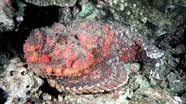
This extremely venemous reef stonefish blends into its environment. (Photo: Dr John E. Randall)
|
stonefish - species of carnivorous bony fishes in the scorpionfish family, Scorpaenidae. Stonefishes are usually found resting on the bottom, practically invisible because of their resemblance to the coral or rocky substrate. Its mottled color pattern and fleshy projections make a nearly perfect camouflage. They are distributed in the shallow tropical marine waters of the Indopacific, feeding mostly upon small fishes and crustaceans. Its dorsal fin possesses spines that release a highly venomous toxin, making it the most dangerous of known venomous fish. On occasion, stonefish stings have proved fatal to humans |
stony coral - a synonym of hard coral |
stop codon - a codon in mRNA for which there is no corresponding trNA molecule to insert an amino acid into the polypeptide chain. Protein synthesis is terminated and the completed polypeptide is released from the ribosome. Three stop codons are known: UAA, UAG, and UGA. Mutations which generate any of these three codons in a position which normally contains a codon specifying an amino acid are known as 'nonsense mutations'; also called 'nonsense codons.' A stop codon signals the end of the amino acid chain in protein synthesis |
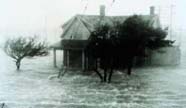
Storm surge swamps a house. (Photo: NOAA)
|
storm surge - a rise above normal water level on the open coast due to the action of wind stress on the water surface |
str (short tandem repeats) - repetitive segments of DNA of a pattern of length from 2 to 10 bp, scattered throughout the genome in the non-coding regions between genes or within genes (introns), often used as markers for linkage analysis because of high variability in repeat number between individuals. These regions are inherently unstable and susceptible to mutations |
strain - a group of individuals within a species having a common origin; a specific genetic variant of an organism; a pure-breeding lineage, usually of haploid organisms, bacteria or viruses; the descendants of a single isolation in pure culture |
strand - the narrow littoral marine zone including beach, foredune, and remaining sandy habitat up to the edge of stabilized dune or inland vegetation. Much of this zone is under the influences of salt spray, shifting and abrasive sand, severe storm surf and high tides. Strand occurs from tropical to temperate, even arctic, latitudes and along coastlines of continents and islands |
strand vegetation - vegetation growing on sandy beach and dune areas |
strategic plan - a document used by an organization to align its organization and budget structure with organizational priorities, missions, and objectives. A strategic plan should include a mission statement, a description of the agency's long-term goals and objectives, and strategies or means the agency plans to use to achieve these general goals and objectives |
stratified sampling protocol - multiple transects for sampling a large site at different depth to avoid double counting or missing organisms |
stratigraphy - the branch of geology that deals with the origin, composition, distribution and succession of strata |
stream bed - the stream bottom or surface over which a stream flows |
stressor - a physical, chemical or biological factor that adversely affects organisms; an agent, condition or similar stimulus that causes stress to an organism |
striae - a thin, narrow groove or channel, or a thin line or band especially if several of them are parallel or close together |
striated - marked with lines or grooves |
stridulation - the process in which a biological sound is produced when one body part rubs against another |
stridulation - to produce a sound by rubbing two body parts together. Some fishes make sounds by rubbing together bodily structures, especially skeletal parts |
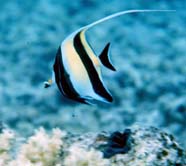
Distinctive striping of the Moorish Idol (Zanclus canescens). (Photo: Dr. James P. McVey, NOAA)
|
stripe - a straight line of pigment that can vary in width, and which can be oriented vertically, horizontally, or obliquely on the head, body, or fins of an organism |
strobe - pertaining to underwater photography, an artificial light device or flash device used to restore wavelengths of light filtered out by water |
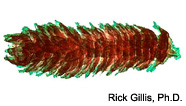
The late strobila stage of the jellyfish Aurelia. This sessile stage contains numerous discs stacked on top of one another. Eventually, each of these discs will break free from the stack as free-swimming ephyra larvae. (Photo: Rick Gillis, Ph.D., Biology Dept., University of Wisconsin-La Crosse)
|
strobila - a stage in the jellyfish life cycle. Free-swimming scyphozoan (true jellyfishes) medusae produce gametes which give rise to small polyps called scyphistomae. After a period of growth, a scyphistoma divides transversely to become a strobila that resembles a stack of discs. Each of the "discs" becomes an ephyra larva, detaches from the strobila and swims freely in the plankton. The ephyra larva will eventually grow into an adult medusa |
stromatolite - a layered, fossilized deposit, mainly of limestone, formed by photosynthesizing colonial cyanobacteria and other microbes. They are the oldest known fossils, dating back more than 3 billion years. Stromatolites are prokaryotes that thrived in warm aquatic environments and built reefs much the same way as coral does today. They were common in Precambrian time (i.e., more than 540 million years ago). Although stromatolites continue to form in certain areas of the world today, they grow in greatest abundance in Shark Bay in western Australia |
stromatoporoid - a fossil calcareous sponge |
structural complexity - as pertaining to coral reef ecosystems, a measure of the amount of coral surface area in relation to linear area. For example, branching coral reef habitats will have a higher structural complexity than encrusting coral reef habitats |
structural gene - a DNA sequence that forms the blueprint for the synthesis of a polypeptide, such as an enzyme |
structure-forming deep corals - any colonial, azooxanthellate corals generally occurring at depths below 50 meters that provide vertical structure above the seafloor that can be utilized by other species. It includes both branching stony corals that form a structural framework (e.g., reefs) as well as individual branching coral colonies, such as gorgonians and other octocorals, black corals, gold corals, and lace corals. These structure-forming deep corals include a number of very different species that contribute to three-dimensionally complex habitats in deeper waters. Structure-forming deep corals are defined as those coral species with complex branching morphology and sufficient size to provide substrate or refuge for associated fishes and invertebrates |
stygobite - a species generally restricted to subterranean groundwater |

When a cnidocyte is fired, it is turned inside out and a stylet punctures the prey, injecting toxins which may cause paralysis. (Photo:Doug Bray, William Nalder/Univerity of Alberta)
|
stylet - a needle-like structure; in cnidarians, when a cnidocyte is fired, it is inverted and a stylet pierces the skin of the prey allowing toxins to be injected; a piercing structure in in some invertebrate mouthparts; also called "lancet" |
styliform - having the shape of a pointed rod |
subadult - an individual similar to the adult in appearance but not yet capable of reproducing |
subclass - a taxonomic group that is below a class and above an order |
subduction - the process in which one lithospheric plate collides with, and is forced down under another plate |
Subersic acid - an antiinflammatory agent derived from marine sponges in the genus Suberea |
subfamily - a taxonomic group that is below a family but above a genus |
subgenus - a taxonomic group that is between a genus and a species |
subgular - below the throat |
subkingdom - a taxonomic group comprising a major division of a kingdom |
sublimation - the transition of a substance from the solid phase directly to the gaseous phase, or vice versa, without passing through an intermediate liquid phase |
submarine canyon - a long, narrow, steep-walled undersea valley |
submarine groove - a troughlike depression with vertical to overhanging walls which cut across the reef front at right angles |
submerged bank - a large, relatively flat shoal or other expansive submerged feature that is markedly shallower than the surrounding ocean bottom |
submerged cultural resource - an historical ship, aircraft, or other cultural artifact that has come to rest on the ocean bottom |
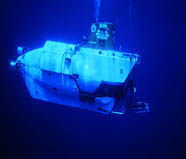
The three-person submersible Alvin could dive to just under 15,000 feet, enabling it to reach 86 percent of the world's ocean floor. (Photo: Rod Catanach, Woods Hole Oceanographic Institution)
|
submersible - a small underwater vessel (submarine) which requires a support ship to transport it to and from the diving area. It is used primarily for oceanographic research. There are also some commercial submersibles that carry tourists below scuba diving depths to view coral reef walls |
Submersible Habitat for Analyzing Reef Quality (SHARQ) - a large-scale underwater incubation chamber designed by USGS scientists to isolate a mass of water over the ocean bottom. This enables scientists to measure changes in water chemistry that result from benthic community metabolism and to calculate metabolic rates associated with different types of benthic habitats |
suborbicular - nearly circular |
suborbital - an area below the eye |
suborder - a taxonomic group that is a subdivision of an order |
subordinate - in taxonomy, belonging to a lower or inferior taxonomic rank. For example, a genus is subordinate to the family to which it belongs |
subordinate taxon - in taxonomy, a taxon at a lower rank than the taxon of the same coordinate group with which it is compared |
subphylum - a taxonomic group ranking that is between a phylum and a class |
subplocoid form - a coral growth form in which the corallites are sometimes separated by coenosteum |
subpopulation - a well-defined set of interacting individuals that compose a proportion of a larger, interbreeding population |
subradular organ - a sensory organ in chitons (Polyplacophora-Mollusca) which can be protruded and pressed against the substrate in the search for food |
subset - in mathematics, a subset of a given set is a collection of things that belong to the original set |
subsidence - a gradual sinking of land with respect to its previous level; the slow sinking of air, usually associated wit high-pressure areas |
subspecies - a taxonomic group that is a division of a species. It usually evolves as a consequence of reproductive isolation of one or more populations within a species |
subspecific name - the third term of the trinomen, a subspecies |
substrate - the material making up the base upon which an organism lives or to which it is attached |
subterminal - located some distance away from the end |
subtidal - permanently below the level of low tide; a continually underwater environment |
subumbrella - the lower or oral surface of a medusa or jellyfish |
subunit - in protein chemistry, an individual polypeptide chain in a protein which contains more than one polypeptide chain |
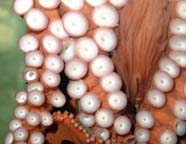
Suckers on an octopus tentacle allow the animal to adhere to almost any surface. (Photo: J'nie Woosley/National Zoological Park)
|
sucker - a structure, such as those at the end of tube feet of echinoderms, or on the tentacles of octopods and squids, that can produce a small vacuum and enable the animal to stick to many surfaces |
sucker - any organ which has an adhesive action |
sucking disk - a disk-like structure used by some fishes to attach itself to rocks or vegetation |
Sula Reef - a deep water Lophelia reef located on the Sula Ridge on the Mid-Norwegian shelf at depths of 200 - 300 m. A very large deep water coral reef, it is about 13 km long, 700 m wide, and up to 35 m high |
Sulu-Sulawesi Seascape - an area of approximately 900,000 square kilometers (about 347,492 square miles) that includes the Sulu and Sulawesi Seas, in the national waters of three independent nations of the Southeast Asian Region: Indonesia, Malaysia, and the Philippines |
summit - the highest part or point; the top |
Sundarbans - the world's largest mangrove forest located in Bangladesh at the edge of the delta where the Ganges, Brahmaputra and Meghna Rivers come together |
super sucker - an underwater vacuum that removes invasive algae from coral reefs. It works by having divers feed algae into a vacuum tube that deposits the algae onto a barge. The algae are sorted to return any incidentally captured organisms and water to the sea. The algae may be recycled and used as fertilizer. This operation was initiated as a pilot project in Kane'ohe Bay, HI in 2005 |
superclass - a taxonomic group that is below a phylum and above a class |
superfamily - a taxonomic group that is below an order but above a family |
superficial cleavage - a type of cleavage, typical of centrolecithal eggs found in most arthropods, in which karyokinesis (nuclear division) occurs without cytokinesis (cytoplasmic division), resulting in a syncytium. Cleavage furrows form to separate the nuclei |
Superfund - money collected from a special tax on chemical feedstocks and raw petroleum. When a responsible party can not pay, Superfund money can be used by the US Environmental Protection Agency (USEPA) to investigate, evaluate, and clean up the hazardous waste sites identified on the National Priorities List (NPL); Superfund is also used to refer to USEPA's program for investigation and cleanup of hazardous waste sites |
supergene - a group of neighboring genes on a chromosome that tend to be inherited together and sometimes are functionally related |
superior - the anatomical term for "above" (e.g., the head is superior to the shoulder) |
supermale - a male which does not change sex and is the principal spawner |
supernatant - the soluble liquid fraction of a sample after centrifugation or precipitation of insoluble solids |
supernumerary - superfluous or extra |
superorder - a taxonomic group that is above an order and below a class or subclass |
superorganism - an "organism" which consists of many organisms, such as coral or the Portuguese man-of-war (a superorganism appears to be one organism, but in fact is a number of colonial animals joined together); a social unit of animals where division of labor is highly specialized and where individuals are not able to survive by themselves for extended periods of time. An ant or bee colony is another example of a superorganism. The concept of superorganism is controversial among some scientists |
supporting cell - in cnidarians, a columnar cell of the epidermis or gastrodermis whose apical end may bear microvilli, cilia, or flagella |
suppressor gene - a gene that can reverse the effect of a mutation in other genes, i.e., a gene that suppresses the phenotypic expression of another gene, especially of a mutant gene |
supraesophageal gangia - a nerve plexus above the esophagus in the head of malacostracan crustaceans |
supraesophageal ganglion - in arthropods, worms, and other invertebrates, the supraesophageal ganglion forms the brain, which typically contains integrative centers for the major senses |
supraorbital - an area above the eye |
suprapsammon - organisms which swim just above sand and are dependent upon it as a food source |
supratidal - above the level of high tide; a terrestrial environment that is influenced by proximity to the sea. Such influences include sea spray, sea breezes and aeolian processes, and geological and biological “spillover” such as dune development |
surf - a collective term for "breakers"; the wave activity in the area between the shore line and the outermost limit of breakers. In literature, surf usually refers to the breaking waves on shore and on reefs |
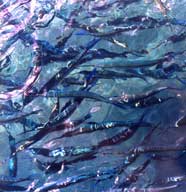
Needlefish feeding at the surface in Oahu (Photo: Mary B. Hollinger/NOAA)
|
surface feeder - an organism, usually a fish, that takes its food from the air/water interface, or feeds just below the water surface, e.g., a needlefish |
surface interval - the length of time that a scuba diver spends on the surface between two consecutive dives |
surface water - an open body of water, such as a stream, lake, reservoir or wetland |
surge channel - a deep channel in the windward side of a coral reef through which water moves in and out of the reef |
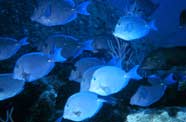
A school of surgeonfish (blue tang) in the Florida Keys (Photo: Florida Keys National Marine Sanctuary)
|
surgeonfish - any species of brightly colored reef-dwelling bony fishes in the family Acanthuridae which have laterally compressed bodies and possess one or more sharp erectile spines near the base of the tail; also called "tangs" and "doctorfish" |
surrogate species - small number of species whose distributions and abundances are well known; used in conservation planning; assumed to reflect the distribution and abundance of the regional biota; subsumes indicators and umbrella species; also called "focal species" |
survey (biology) - the systematic and usually standardized collection or inventorying, processing, and analysis of representative portions of a biological community or defined site with its habitats, to determine the community structure and function |
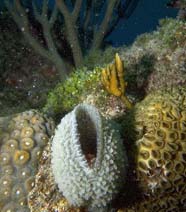
Suspension-feeding sponge among corals.
|
suspension feeder - an organism that feeds by capturing particles suspended in the water column. A synonym of filter feeder |
sustainability science - a multi-disciplinary approach to science that recognizes the limitations of traditional scientific inquiry in dealing with the complex reality of social institutions interacting with natural phenomena. Sustainability science seeks to improve on the substantial but limited understanding of nature-society interactions gained in recent decades. This has been achieved through work in the environmental sciences estimating and evaluating human impacts, and evidence from social and development studies that takes into account environmental influences on human well-being. Urgently needed is a better understanding of the complex dynamic interactions between society and nature so that the trend towards increasing vulnerability is reversed |
sustainable development - those efforts to guide economic growth in an environmentally sound manner with an emphasis on natural resource conservation |
Sustainable Production Marine Protected Area (MPA) or Zone - MPAs or zones established and managed wholly or in part with the explicit purpose of supporting the continued extraction of renewable living resources (such as fish, shellfish, plants, birds, or mammals) that live within the MPA, or that are exploited elsewhere but depend upon the protected area’s habitat for essential aspects of their ecology or life history (feeding, spawning, mating, or nursery grounds). Examples include some national wildlife refuges and many federal and state fisheries areas, including those established to recover over-fished stocks, protect by-catch species, or protect essential fish habitats |
sustainable yield - the number or weight of organisms in a population that can be harvested without reducing the population biomass from year to year, assuming that environmental conditions remain the same |
suture - the line of union of two bones or plates |
swamp - a type of wetland that is dominated by woody vegetation. When it does not, it is usually termed a marsh. Swamps may be fresh or salt water and tidal or non-tidal |
swath - the area of Earth's surface or atmosphere measured by an instrument during a single satellite overpass; a path or strip |
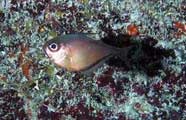
A glassy sweeper (Pempheris schomburgki) photographed at Bimini (Photo: Mark Rosenstein/Active Window Productions (markrosenstein.com))
|
sweeper - any of about 25 species of bony fishes in the family Pempheridae. Sweepers may be found around coral reefs in the Atlantic, Pacific, and Indian Oceans. They have deep, laterally compressed bodies and a single, short dorsal fin. During the day, schools of sweepers may hover in caves, and come out at night to feed on plankton |
sweeper polyp - a polyp that acts in an aggressive manner by stinging neighboring corals and sessile invertebrates |
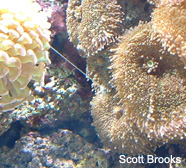
A hammer coral (right) thrusts out a sweeper tentacle towards a mushroom anemone (left). (Photo: Scott Brooks)
|
sweeper tentacle - A coral polyp tentacle that has an increased number of nematocysts and elongates in order to 'sting' neighboring corals and sessile invertebrates. A tool in the competition for space and resources |
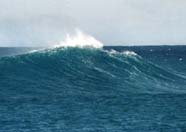
An ocean swell
|
swell - the persistence of a wind-formed wave after the wind ceases |

The arrow points to a swimmeret of a juvenile lobster. (Graphic: NOAA)
|
swimmeret - one of several flat, fringed, and usually bilobed, paired appendages on the ventral surface of the abdominal somites of decapod crustaceans, used for swimming and reproduction |
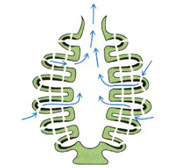
Anterior end of a syconoid sponge in which the body wall has been folded into a series of internal and external canals.-1= osculum; 2= spongocoel; 3= ostium; 4= radial canal; 5= incurrent canal; 6= apopyle. (Photo: Rick Gillis, Ph.D., Biology Dept., University of Wisconsin-La Crosse)
|
syconoid - a body form of medium complexity in sponges where the body wall has become folded and the choanocytes (flagellated collar cells) are not located along the spongocoel, but along radial canals. Water enters the sponge through a series of incurrent canals and passes through internal pores called prosopyles into the radial canals, which are lined with flagellated choanocytes.- It is the action of these choanocytes that keeps water moving through the sponge. From the radial canals, water then enters the central spongocoel through pores called apopyles, to exit to the environment through a single opening, the osculum. |
Symbiodinium microadriaticum - a dinoflagellate symbiont (zooxanthellae) in marine cnidarians |
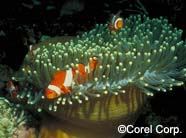
These clownfish exist in a symbiotic relationship with the sea anemone; the anemone provides protection and the clownfish feed and clean the anemone. Different clownfish species choose particular anemone species for their hosts. (Photo: Copyright Corel Corp.)
|
symbiont - a symbiotic organism; either of two organisms participating in a symbiotic relationship |
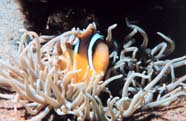
A clownfish has a symbiotic relationship with a sea anemone, finding protection within the clump of stinging cell-bearing tentacles.
|
symbiosis - a relationship between two species of organisms in which both members benefit from the association (mutualism), or where only one member benefits but the other is not harmed (commensalism), or where one member benefits at the expense of the well-being of the other (parasitism) |
symbiosome - a double-membraned cell vesicle, composed of an endosymbiont with its plasmalemma (as inner membrane) and a non-endosymbiotic, host-derived outer membrane (the perisymbiontic membrane); the site of nutrient and gaseous exchange for zooxanthellae in the tissues of some cnidarians |
sympatric species - different species that live in the same area but are prevented from successfully reproducing by a reproductive isolating mechanism |
symplesiomorphy - in evolution, a shared primitive character |
sympodial growth - growth of a coral colony in which the colony does not produce a trunk. New polyps offshoot along the edges of adult polyps. The youngest polyps are always on top of colony |
synapomorphy - in evolution, a shared derived character |
synapse - the site where neurons communicate with each other. A synapse is a small gap that physically separates neurons. Axon terminals of a neuron sending a nervous impulse (the presynaptic neuron) release neurotransmitters into the synapse. The neurotransmitters diffuse to the other side (the postsynaptic side) where they bind to receptors on the postsynaptic neurons, thereby relaying the nervous impulse |
synapticulum - a conical or cylindrical supporting process, as those extending between septa in some corals |
synbiotic - an appropriate synergistic combination of pre- and probiotics |
synchronous - occurring at the same time |
synchronous breeding - a breeding system in which all members of the population tend to breed at the same time |
synchrony - the relation that exists when things occur at the same time |

Skeletal muscle cells are a multinucleate syncytium. The dark stained bodies are nuclei. (Photo: General College, University of Minnesota)
|
syncytium - a mass of cytoplasm containing several nuclei and enclosed in a membrane, but having no internal cell boundaries, e.g., skeletal muscle cells |
syndrome - a set of signs occurring together; the sum of signs of any diseased state |
synecology - the branch of ecology that deals with whole communities and the interactions of the organisms within them |
synergism - an interaction between agents (eg, drugs) that produces an effect greater than the combined effects of the same agents used separately |
syngameon - a group of discrete morphological units (semispecies) that are interfertile; a cluster which comprises several morphospecies, i.e., "all of species or semispecies linked by frequent or occasional hybridization in nature |
syngamy - the process of union of two gametes, also called fertilization. It encompasses both plasmogamy and karyogamy. |
synomone - a chemical substance produced by one organism that is beneficial to both itself and a member of another species |
synonym - in taxonomy, one of two or more scientific names that are spelled differently, but refer to the same organism |
synonymous substitution - in molecular biology, a nucleotide substitution that does not result in an amino acid replacement |
synonymy - in taxonomy, the relationships between different names applied to the same taxon; a chronological list of taxonomic names which have been applied to a single taxon, including authors and dates |
synopsis - in taxonomy, a brief description of the main characters of a taxon |
syntopic - relating to or displaying conditions as they exist simultaneously over a broad area; pertaining to populations or species that occupy the same macrohabitat |
syntype - in taxonomy, each specimen of a type series from which neither a holotype nor a lectotype has been designated. The syntypes collectively constitute the name-bearing type |
systemic - a condition or process that affects the body as a whole, not localized to one area or system |
|
|
|
|

